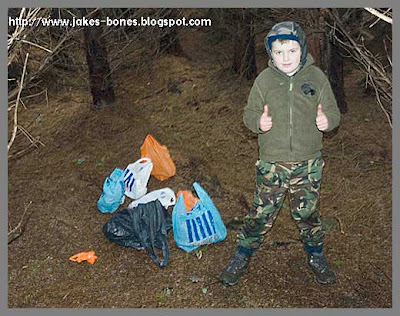You can read the second one here.
I haven't written the third one yet !

This week's post is about how I collected a great red deer stag skeleton. On Friday morning, dad and I went up to Suicides Graves wood to collect a skeleton which dad noticed a few weeks before. He brought the skull back to show me, but left the rest.
This is what I take in my rucksack for collecting bones:

- Rubber gloves - this is so you don't get germs on your hands and you can put small bones in them, I don't always wear rubber gloves unless the bones are gooey.
- A pencil - this is for writing numbers on ribs and vertabrae
- Baby wipes - these are for wiping your hands
- Plastic bags - are for putting the bones in.
- My camera - to take pictures of the bones.
- Hand gel - to clean your hands afterwards

Then when he looked into the wood, he saw a lot more bones scattered about:

The parts you can see are:
- Front leg
- Back leg
- Toes from the back leg
- The main part of the body
This is what the front leg in that photo looked like.

The parts you can see are:
- Humerus - this is the bone that in humans goes from the shoulder to the elbow
- Radius - this is one of the bones that in humans goes from the elbow to the wrist
- Ulna - this goes next to the radius
- My perry whistle - to put something in the pictures to see how big the bones were. Scientists do this, but they use a ruler or something else like it.
- Carpal bones -these are lots of little bones like our wrist bones
- Metacarpal - in humans these bones goes between your wrist and knuckle inside your hand. Deer metacarpals are much bigger, they only have one, and it is their bottom leg bone.
- Toe bones - Deer have two big toes on each leg.

When I picked up the radius and ulna, they were joined together at the bottom. Normally, they are two bones, but when the deer gets older they join together. That means this red deer stag was starting to get old.

I took pictures of every part before I moved the bones.

This is where the red deer's body lay. Its head would have been on the right and it's bottom would have been on the left. You can't see the skull because dad had already brought it back.

- Pelvis - this was in two parts. In very young deer, the pelvis is in four parts, and in very old deer the pelvis all joins together
- Femurs - these are like the thigh bones in humans, the top bone of the back leg.
- Spine and ribs - this is where the main body was
- Shoulderblade - the other is under the ribs
- The neck bones -which are really part of the spine. The top bone, the atlas, is just above these in the picture.

The neck was the same when I picked it up, but when I dropped it some of the bones came apart.

We found some of the hooves, but we didn't take them because hooves can rot. The big hoof is from one of the big toes, and the small hoof is from one of the back toes that are a little bit up the leg, and deer don't really use them.

We put each part of the deer into a different bag, then we had to fit the bags into our rucksacks. Red deer are huge. You couldn't carry all the bones by yourself. It was lucky dad brought the skull back earlier.

I am going to clean up the bones then write the next part when the bones are clean and dry. This is a great skeleton ! I have called this skeleton Roger.
You can read the second one here.
I haven't written the third one yet !
Enjoy this post ? Share it !





















